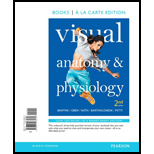Solutions for Visual Anatomy & Physiology, Books a la Carte Plus MasteringA&P with eText -- Access Card Package (2nd Edition)
Browse All Chapters of This Textbook
Book Details
NOTE: Books a la Carte are unbound, three-hole-punch versions of the textbook. This lower cost option is easy to transport and comes with same access code or media that would be packaged with the bound book.
Visual Anatomy & Physiology combines a visual approach with a modular organization to deliver an easy-to-use and time-efficient book that uniquely meets your needs–without sacrificing the comprehensive coverage of A&P topics required for careers in nursing and other allied health professions. The Second Edition addresses tough physiology topics with new and revised two-page modules and corresponding new Coaching Activities in MasteringA&P. Brand-new end-of-chapter study and practice materials include a narrative Study Outline and comprehensive Chapter Review Questions. Module Reviews and Section Reviews, appearing throughout each chapter, give you additional tools for learning. In response to the strong demand from A&P instructors, a brand-new Visual Anatomy & Physiology Lab Manual uses the same visual approach and modular organization to help you succeed in the lab.
This program presents a better teaching and learning experience by providing:
- Personalized learning with MasteringA&P: Become engaged with new “tough topic” Coaching Activities and a wide range of other question and activity types–all automatically graded.
- A visual approach and modular organization: The two-page modules seamlessly integrate text and visuals to guide you through complex topics and processes with no page flipping. The addition of new content in select modules gives you a better understanding of physiology.
- Frequent practice: Review questions at the end of each module, section, and chapter encourage and support practice. In the Second Edition, the Chapter Review includes a new comprehensive Study Outline and new traditional Chapter Review questions. You can continue practicing with MasteringA&P.
- Learning outcomes that tightly coordinate with teaching points: The clean one-to-one correspondence between the numbered chapter-opening Learning Outcomes and the numbered two-page modules give you an easy learning path and instructors an easy vehicle for assessment.
- Streamlined learning in the lab: The new Visual Anatomy & Physiology Lab Manual uses the same visual approach and modular organization to help you succeed in the lab.
Sample Solutions for this Textbook
We offer sample solutions for Visual Anatomy & Physiology, Books a la Carte Plus MasteringA&P with eText -- Access Card Package (2nd Edition) homework problems. See examples below:
More Editions of This Book
Corresponding editions of this textbook are also available below:
